Letter from New York: Visual Arts — Alice Neel and All the Rest
By David D’Arcy
In New York, museums and galleries are racing toward a new normal, whatever that might be. Most exhibitions that opened earlier in the year will stay open into the summer.
Alice Neel: People Come First at the Metropolitan Museum of Art through August 4. Visitors should arrive at the Met early to avoid waiting.
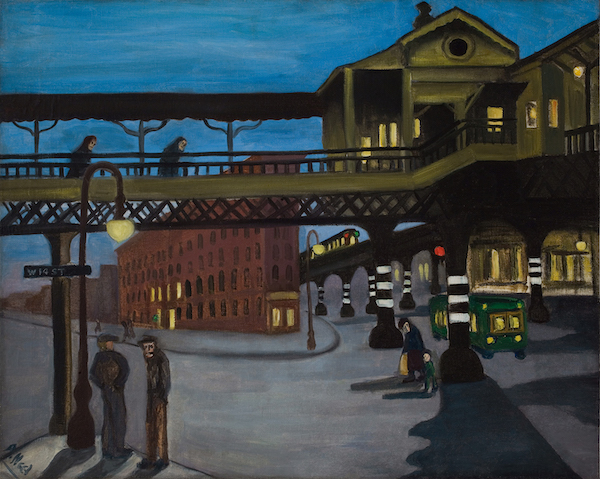
Alice Neel, “Ninth Avenue El,” oil on canvas, 1936. Photo: Metropolitan Museum of Art.
The waiting lines for the Alice Neel exhibition have been compared to those for the Met’s 2011 show of work by the fashion designer Alexander McQueen. Those are long lines. And the tourists aren’t even back yet.
For six decades, Alice Neel (1900-84) painted portraits, mostly of those around her, that took decades to garner critical attention. Her first husband, a Cuban artist, kept their child from her. A jealous lover, a sailor on drugs, destroyed hundreds of her paintings. For a time she fled bohemia for East Harlem where, as always, she painted the people around her. Her communist politics also set her apart, as did her staunch commitment to representational painting after Abstract Expressionism had become the dominant style in the late ’40s.
In an interview, Neel noted that Paul Cézanne said he wanted “to paint people who had grown old in the country.” Neel’s goal, she said, was “to paint people who have been torn to shreds by the rat race.”
Her early portraits were just that, young mothers, expectant mothers, her lovers, her own children and lots of street kids. Add to that group Joe Gould, the notorious Greenwich Village moocher of meals and harasser of women, whom she painted with three penises. Gould liked the portrait.
In 1970, Neel painted Andy Warhol, stripped to the waist, showing where his body had been lacerated after Valerie Solanis shot him in 1968. Warhol, a friend, posed willingly for what was calculated to disconcert. Neel knew that the picture would shock. Given its pastel palette – what else for the pale Warhol? — the picture still does.
Neel could be a charmer. She painted a portrait of Henry Geldzahler, head of the Department of Twentieth Century Art at the Met, who told her he couldn’t show her work because her paintings weren’t really modern. The Whitney gave Neel her first major retrospective in 1974, an entire floor, almost 50 years before the Met caught up to her.

Alice Neel, Elenka, oil on canvas, 1936. Photo: Metropolitan Museum of Art
My favorite picture in the show is Elenka, which is the cover of the exhibition catalogue. The communist intellectual is seen via her head and shoulders, a pose that gives the picture the force of a portrait bust — yet observed closely enough to be delicate and intimate, down to the ring on her finger.
Once you get past Neel’s glow of the moment, and it is intense these days, it’s worth looking again carefully at her work. She did not come out of nowhere. Her paintings call to mind portraits made in Germany after World War I, during the ’20s and ’30s. These faces — meditations on motherhood, childhood, and the everyday — are scrutinized unapologetically, sometimes, as with Gould and Warhol, grotesquely. Her politics can feel like a sympathetic extension of the leftism of the era’s German Expressionism. Another connection: her focus on nudes, whether they are pregnant young mothers or slight art critics, two of whom, she said in an interview, were a bore until they took their clothes off.
How the voluble Neel convinced her subjects to disrobe makes for revealing stories. She painted herself nude at 80, dressed only in eyeglasses and holding a paintbrush, looking back from the canvas with an expression that suggests mistrust. Like most of her late works, the paint does not cover the entire canvas, suggesting a work (or life) in progress.
There is no doubt that Neel’s range of subjects (gay couples and drag queens, Puerto Rican kids, art critics, her family) and her determination (through the ’60s) to view people from the ground up expanded the range of American portraiture. Still, earlier photography of underrepresented groups achieved that goal before she did; her paintings of children in East Harlem, for example, have many affinities with photos of those subjects. Like photography, she prized moments of unease or disturbance. Yet for all of their diversity, Neel’s portraits often seem limited to those moments.
The Met supplies a helpful introduction to the show on its website. More illuminating and entertaining is a 1978 conversation between the bubbly and wildly indiscreet Neel and an imperious interviewer, Barbaralee Diamondstein. Neel’s appearance on the Tonight Show with Johnny Carson in 1984 is also online. For those who want to dig deeper into her life, Alice Neel, the 2007 documentary by her grandson, Andrew Neel, assesses the toll that Neel’s free-spirited ways took on those closest to her. In a world of obsequious art bio-docs, this film is a refreshing work of honesty.
Yayoi Kusama – Cosmic Nature – New York Botanical Garden through October 31
If there is an artist who might just outdraw Alice Neel, it is Yayoi Kusama, now 91, whose colorful works, mostly zoomorphic, mostly sculptures, are part of the outdoor environment at the New York Botanical Garden through October 31.
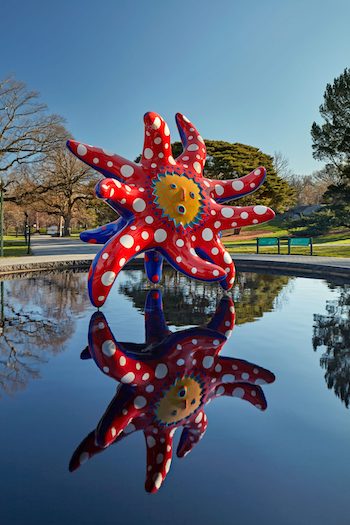
I Want to Fly to the Universe, 2020. The New York Botanical Garden, 2021. Urethane paint on aluminum. © YAYOI KUSAMA.
The Halloween closing date is no coincidence. Kusama makes odd creatures, almost always colorful, often spotted or dotted, and the scale of the Botanical Garden in the Bronx makes it easy for the place to pass for a habitat. (The Bronx Zoo, by the way, is across the street.)
In case you haven’t guessed, this is a show for kids of all ages made by a whimsical woman who may just be the most marketable artist in the world, certainly in the nonagenarian category. But there’s more than crowd appeal here.
Kusama came to New York in the ’60s, drawn to some of the same movements and styles that inspired Yoko Ono at the time — performances, happenings, and grand outdoor sculptures.
But Kusama also suffered from mental illness, which led her to return to Japan, where she chose to live in an institution. As a result, her works are often left to speak for themselves.
I Want to Fly to the Universe, a starfish at the center of which sits the face of the sun, hovers over a central fountain at the NYBG. Paths lead away to other works, such as tall tree trunks wrapped in polka dots — wrapped, not painted, mind you. In a nearby pond, silver floating globes move with the wind like ducks.
Kusama’s work travels widely, so her fans will find styles and shapes that might be familiar, but at the Botanical Garden there is something new. A lane that links two buildings exhibiting Kusama’s sculptures is lined with plantings in forms and colors inspired by the artist. The scale is surprisingly modest and delicate; their colors are more muted than Kusama’s monsters, but these relative miniatures contain a beguiling power. They are easy to miss, but these magical ensembles are worth the trip.
Alexander Calder: Modern from the Start is a selection of works from MoMA’s collection. Calder (1898-1976) had his first one-man show at MoMA in 1943. The institution was founded in 1929 and had already begun to show his work in 1930. MoMA owns enough objects by Calder to do him justice, and this new exhibition approaches that high bar.
It’s a magnificent show, even in low-ceilinged galleries where you would not imagine his work would look so good. It does. If you like Calder — and who doesn’t? — this is a show to see.
Calder was a combination of hardheaded engineer and dreamy magician. The first gallery introduces you to some of the artist’s many strengths. He could take a flat sheet of metal and shape it to create volume and movement. For example, Devil Fish, from 1937, seems to freeze the motions of a dancer in mid-movement.
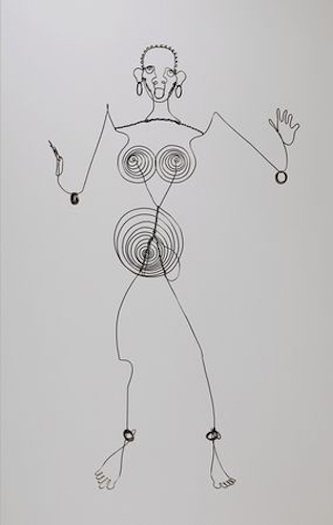
Alexander Calder. Josephine Baker (III), c. 1927. Steel wire. Photo: The Museum of Modern Art, New York.
The mobile Snow Flurry, I (1948) hangs in a distant corner. The pendants of the work are a design in space — or multiple designs, if you count the shadows in motion throughout the day on the white wall behind the work. These shadows offer an additional shifting palette, serving as a kind of doppelgänger to the work itself. The shadows are easier to see at first than the mobile’s white near-transparent pendants. The mobile doesn’t just exist in space, but in time as well. Calder the sculptor worked in four dimensions.
In this first gallery, you feel the surrealists resonate in Calder — or did he resonate in them? It was Marcel Duchamp who christened his moving works “mobiles.”
Calder decided to become an abstract sculptor in the ’30s, a move that he credited to Piet Mondrian. Still, it’s not clear that he ever completely abandoned the figure. Spiney (maquette) (1939), a multipointed ensemble in black, is true to its name. The piece makes you think of Max Ernst or Alberto Giacometti.
Those associations, and the affinities with the master Joan Miró in Calder’s red-painted works, suggest what might be called Calder’s European side, the many influences he absorbed from his time there. His American side — and the border between the two is porous — is that of the problem-solver with a pair of pliers in his hands in his studio in Roxbury, CT.
In the show’s second gallery, we see a full-scale likeness, in wire, of the African-American performer Josephine Baker, a transplant to France like Calder at the time, with the shadow on the wall behind the work serving as a second version of the portrait. Baker was a tall, lean dancer. Wire was an appropriate material for a sculpted likeness of her. Calder approached his subject as if he were drawing her — the piece is essentially a single line.
Positioned across the narrow gallery is a pig (a sow, actually) that doesn’t lose any of its charming porcine volume even though it is a suspended wire sketch. We know from sculptures that you’ll see in MoMA’s garden (and in plenty of American cities) that Calder could be monumental. Here is evidence that he could also be graceful when minimal.
PHOTO | BRUT: Collection Bruno Decharme & Compagnie at the American Folk Art Museum through June 6
Even before cell phones people still had near-universal access to photography, whether it was through cameras or the omnipresence of photographic images. And that access to picture-taking extended to people who were institutionalized or in extreme isolation, even those who were unable to obtain conventional instruction in photography or art.
The photographers in PHOTO | BRUT are people on the margin, and this eye-opening exhibition at the American Folk Art Museum (across Broadway from Alice Tully Hall at Lincoln Center) is made up of their images, photo-collages, and hard-to-classify works. Since almost none of the photos here was made to be seen (outside of a small circle), think of this as a public showing of very private images.
This is an exhibition that everyone must see. AFAM has free admission — you can make a donation — and I never saw a line there.
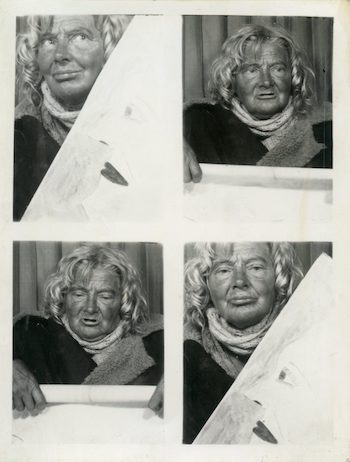
A sample from PHOTO | BRUT: Collection Bruno Decharme & Compagnie. Photo: American Folk Art Museum.
Collector Bruno Decharme acquired the works in the AFAM exhibit, which premiered in 2019 at the Rencontres de la photographie in Arles (France), over a number of years. Here is how he defines his approach:
You could say that the category of brut photography comprises pictures, prints, photomontages, and photo-collages made by creators outside the art world and conventional art circuits, who live in a mental institution or in solitude and marginality, in either the countryside or the city. This sociological definition sets out the borders of an exploratory territory, but the specificity of art brut also enters into play, which is what I find interesting. I love art brut because it involves artists whose production goes well beyond the definitions of art in the Western sense of the term.
That’s an understatement. Take Tomasz Machcinski, born in Poland in 1942, who spent his early years in institutions, where he trained as a shoemaker. He got a Russian-made camera in a trade, so he could take pictures of his real interest — himself. There are 17,000 self-portraits of Machcinski — dressed as women, as male dandies from history, even as Pope John Paul II. “I don’t use wigs or tricks, but I use everything that is going on in my body: receding hair, loss of teeth, illness, aging, etc.,” he explained.
In Milwaukee, Eugene Von Bruenchenhein (1910-83) photographed his wife, attired and undressed. (The artist Man Ray also dressed his wife in costumes and photographed her. And, of course, Cindy Sherman comes to mind.) But Von Bruenchenhein, who supported himself working in a bakery, did not limit himself to photography. He created elaborate landscape paintings and sculpted monstrous creatures from chicken bones — yes, chicken bones.
Unlike many of the artists in PHOTO | BRUT, Von Bruenchenhein is not unknown. He is a local hero in southeastern Wisconsin, and his work (his production, discovered after his death in 1983, was enormous) is continually on view at the John Michael Kohler Arts Center in Sheboygan, an outpost for the exhibition of outsider art, the work of untrained artists.
Another “known” artist in PHOTO| BRUT is Mark Hogancamp, who did odd jobs until 2000, when he was severely beaten at a bar after he admitted to some of the patrons that he liked to wear women’s clothes. (He was revived after being initially declared dead). Left with almost no memory, he created a parallel world set in the fictional Marwencol, in World War II Belgium, where captive US soldiers are freed by women. Hogancamp’s photographs of the scenes in his dream world are on view. Hogancamp’s project inspired the documentary Marwencol and the dramatic feature film, Welcome to Marwen. Hogancamp’s chronicle continues on his website and YouTube channel.
Narratives born out of trauma, especially memories and fantasies of war, can be found throughout the photographs and collages in PHOTO | BRUT, many of which are from the former Soviet Union. The word to describe the overall effect would be kaleidoscopic, though the cramped galleries at AFAM give you the feeling you are in an enclosure filled with prisoners who are obsessed with telling (and illustrating) their stories. The low light enhances the claustrophobic effect.
Then there is the outlier among outliers (and that’s saying something), Kazuo Handa (1952-2016), of Japan, who loved to smoke, and who made cigarette holders, pipes, and ashtrays out of photographs from pornographic magazines that he cut into strips and then rolled together. A selection of his many thousands of objects are on view. True to his tobacco-fueled pleasure to the end, Handa died of mouth cancer.
“To reread photography in the light of images that are unpolished, simple, and made by creators — often solitary and generally obsessive — whose intention is not to make a work of art but to satisfy their need for expression is to open Pandora’s box,” one of the show’s curators, Sam Stourdzé, writes in the catalogue. “Because the photographic image affirms its omnipresence, it becomes the medium for all the stories in the world.”
Niki de Saint Phalle: Structures for Life at MoMA PS1 through September 6
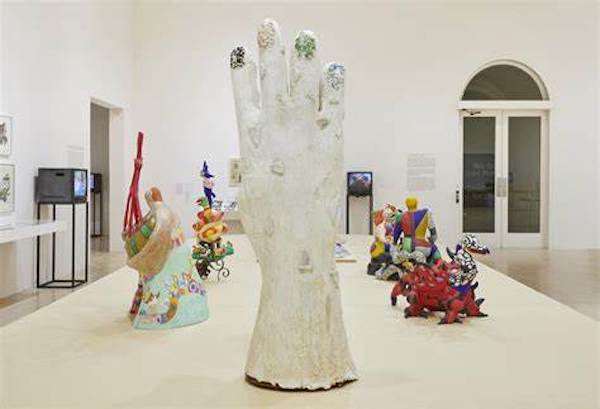
Installation view of Niki de Saint Phalle: Structures for Life, Photo: courtesy MoMA PS1. Kyle Knodell
Niki de Saint Phalle (1930-2002) was an heiress, a feminist, and a revolutionary. She is best remembered for shooting her paintings with a rifle. She later created figures out of baglike body parts, which she also shredded with bullets. Others were invited to shoot them up as well. Those works of art, which she called “Tirs,” or “Shots,” suggested other targets, symbols of authority, like men.
Saint Phalle’s second husband was Jean Tinguely, whose 27-foot Homage to New York (1960) became a defining work of its time, an icon of frenetic movement and mechanized self-destruction.
Saint Phalle moved on to sculptures that she called “Nanas” (“Chicks” or “broads” in French slang), monumental feminine figures who exuded a proud, swaggering comic presence. They were balloon-shaped; they looked pregnant or just whale-like. All were colored brightly — a subversive alternative to the huge round figures that Fernando Botero marketed in museums and galleries.
This was the era of Pop Art, some of which looked as if it were made to be destroyed. It was also the era of happenings, when one of the demands of making something was that it would become part of an event.
Niki de Saint Phalle: Structures for Life will introduce this wildly free-spirited artist to generations who haven’t been exposed to her work. And Saint Phalle deserves the new exposure, if only because her satiric humor is hard to resist.
Saint Phalle, who also made films of herself shooting her work, led the madcap life of a rom-com heroine. Born into a rich aristocratic family, she was expelled from the Brearley School in New York for painting the fig leaves on Greek-inspired statues red. She eloped, and then led a bohemian life in Europe, where her paths crossed with Salvador Dalí, along with just about every artist who lived la dolce vita.
An entrepreneur who financed some of her production by marketing a perfume, Saint Phalle couldn’t resist making her art monumental. A brazen example, from 1966, is “Hon-en-katedral” (She-a-cathedral). It was a plump recumbent female figure, made of plaster on a metal frame, so large that visitors could enter the figure’s lower body via a portal between her legs. The construction showed at the Moderna Museet in Stockholm, which might have been the only city in the world at the time where a museum could get away with something so bold. The mega-sculpture broke attendance records.
“Structures for Life” supplies ample space for a look at Saint Phalle’s work from the ’80s and later, pieces which even her ardent fans find hard to celebrate. Most of the attendees at the PS1 show will probably need a second or third visit to properly appreciate an artist who can simultaneously be bawdy, raunchy, and wholesome.
Saint Phalle died in 2002, at 71, from complications caused by the chemicals that she used to make her work. Her interviews, which provide an informative introduction to her politics and production, are all over YouTube, in English and French. They are lively performances from a woman who embraced the contemporary artist’s obligation to perform.
David D’Arcy, who lives in New York, writes about art and film for many publications, including the Art Newspaper. He produced and co-wrote the documentary Portrait of Wally (2012), about the fight over a Nazi-looted painting found at the Museum of Modern Art in Manhattan.
Tagged: “Niki de Saint Phalle: Structures for Life, Alexander Calder: Modern from the Start, Alice Neel, American Folk Art Museum, Collection Bruno Decharme & Compagnie, Cosmic Nature, David D'Arcy, Metropolitan Museum of Art, MoMA, MoMA PS1, New York Botanical Garden, PHOTO | BRUT
